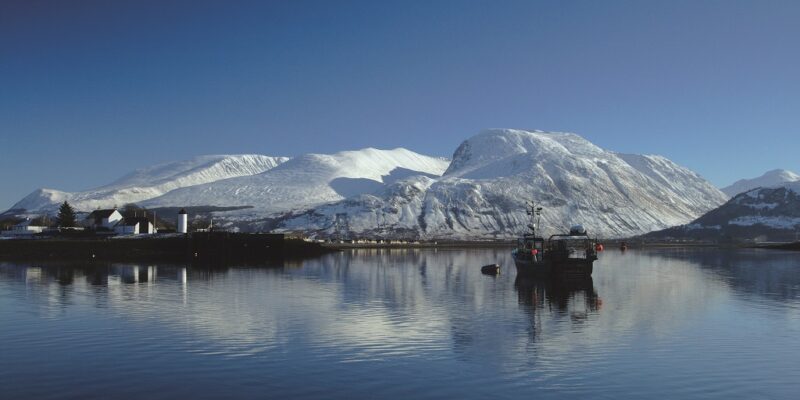Scotland’s highest munro is not to be taken lightly and there are lots of places to view it if you don’t want to go all the way to the top
MORE FROM SCOTLAND MAGAZINE
Stand on the banks of the Caledonian Canal, at Corpach, a couple of miles north of Fort William, and look east. Here you will be treated to one of the finest views in Scotland, one that takes in a mountain of such epic proportions that it dwarves everything below, a mountain that rises higher than any other point in Britain.
That mountain, of course, is Ben Nevis. Ben Nevis rises to 1,345m (4,411 feet) above sea level, and it is a huge mountain in every respect. Its circumference measures approximately 17.5km (11 miles) around its base while its bulk can be seen from many miles around, from Skye in the Inner Hebrides to the Arctic plateau of the Cairngorms, some 90km (56 miles) to the northeast.
Being Britain’s highest peak, Ben Nevis is, unsurprisingly, an extremely popular mountain to climb. Around 125,000 walkers reach the summit annually with most ascents made via the Mountain Track that rises from Glen Nevis. Although this is the simplest means of reaching the top, it is still a very challenging 17km (10.5-mile) route – even on a clear summer’s day – with around 1,352m (4,400 feet) to climb and then descend. Tired knees and aching thighs are a regular occurrence when walkers finally return to the Glen Nevis visitor centre having climbed ‘The Ben’, as Ben Nevis is affectionately known.
The derivation of the name ‘Nevis’ has been open to much conjecture, but it is thought to mean ‘venomous’, from the Old Gaelic ‘Nimheis’ and, certainly, in some weather conditions its name is wholly appropriate; a climb to the summit during wintry, wet or windy conditions means Ben Nevis takes on a different guise entirely. Especially when enveloped in an icy garb.

Snow can linger in and around the summit well into the summer but during the winter months snow can lie thick on the lower slopes – removing any sign of the path – while it can be several feet deep at the top. Likewise, snow cornices can also cover the steep cliff edges of Ben Nevis’s celebrated North Face well into summer and real care should be taken, at any time, if approaching the lip.
There can also be a difference of around 10 degrees centigrade between Glen Nevis and the summit of Ben Nevis. As such, if it’s zero degrees at the base then it could be a toe-numbing -10 on the summit plateau. Add in wind chill and you have temperatures that become dangerous. Consequently, always dress appropriately for the forecast and seriously consider how quickly the weather can change.
Ben Nevis also has several different sides to it. From the attractive shores of Loch Linnhe – a sea loch that flows southwest from Fort William – the mountain takes on a rounded form with, what appears to be, a flattish summit. However, to fully appreciate the true extent of Ben Nevis’s grandeur and scale then it must be seen from the banks of Allt a’ Mhuilinn (the Stream of the Mill) or, even better, from the neighbouring peak of Càrn Mòr Dearg (the Big Red Cairn).
From Allt a’ Mhuilinn the astonishing north face of Ben Nevis, and its many corries and cliffs, such as Tower Ridge and Five Finger Gully, make this side one of the best mountaineering locations in the world, and it never fails to take the breath away.
A superb 11km (seven-mile) walk along a good path, leaves from the North Face Car Park at Torlundy, and rises along the banks of Allt a’ Mhuilinn to reach the Charles Inglis Clark (CIC) Memorial Hut that sits beneath the incredible crags of the north face.

Here, the walker is surrounded by one of the finest landscapes in Scotland, one with a real Alpine quality, with the colossal buttresses of Coire Leis and Càrn Mòr Dearg rising skywards for several hundred metres. Golden eagles may be seen high on the thermals above with carnivorous sundew, bog asphodel, tormentil, rowan, birch and hawthorn lining the path and riverbank.
This is an extract. Read the full feature in the May/June 2021 issue of Scotland.
Read more:
MORE FROM SCOTLAND MAGAZINE

SCOTLAND MAGAZINE
Published six times a year, every issue of Scotland showcases its stunning landscapes and natural beauty, and delves deep into Scottish history. From mysterious clans and famous Scots (both past and present), to the hidden histories of the country’s greatest castles and houses, Scotland‘s pages brim with the soul and secrets of the country.
Scotland magazine captures the spirit of this wild and wonderful nation, explores its history and heritage and recommends great places to visit, so you feel at home here, wherever you are in the world.